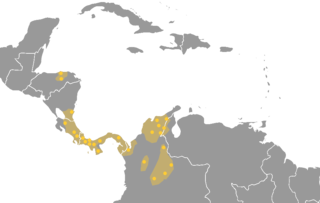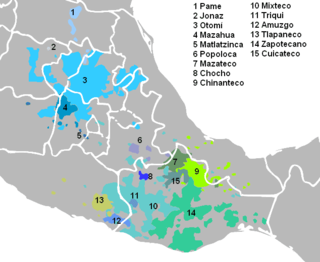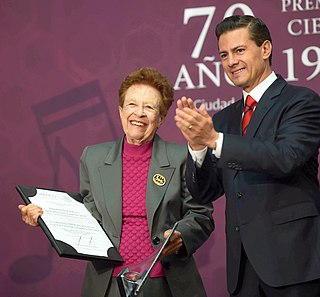Related Research Articles

The Chibchan languages make up a language family indigenous to the Isthmo-Colombian Area, which extends from eastern Honduras to northern Colombia and includes populations of these countries as well as Nicaragua, Costa Rica, and Panama. The name is derived from the name of an extinct language called Chibcha or Muysccubun, once spoken by the people who lived on the Altiplano Cundiboyacense of which the city of Bogotá was the southern capital at the time of the Spanish Conquista. However, genetic and linguistic data now indicate that the original heart of Chibchan languages and Chibchan-speaking peoples might not have been in Colombia, but in the area of the Costa Rica-Panama border, where the greatest variety of Chibchan languages has been identified.

The Chinantec or Chinantecan languages constitute a branch of the Oto-Manguean family. Though traditionally considered a single language, Ethnologue lists 14 partially mutually unintelligible varieties of Chinantec. The languages are spoken by the indigenous Chinantec people who live in Oaxaca and Veracruz, Mexico, especially in the districts of Cuicatlán, Ixtlán de Juárez, Tuxtepec and Choapan, and in Staten Island, New York.

Mesoamerican languages are the languages indigenous to the Mesoamerican cultural area, which covers southern Mexico, all of Guatemala, Belize, El Salvador, and parts of Honduras, Nicaragua and Costa Rica. The area is characterized by extensive linguistic diversity containing several hundred different languages and seven major language families. Mesoamerica is also an area of high linguistic diffusion in that long-term interaction among speakers of different languages through several millennia has resulted in the convergence of certain linguistic traits across disparate language families. The Mesoamerican sprachbund is commonly referred to as the Mesoamerican Linguistic Area.

Uto-Aztecan, Uto-Aztekan or Uto-Nahuatl is a family of indigenous languages of the Americas, consisting of over thirty languages. Uto-Aztecan languages are found almost entirely in the Western United States and Mexico. The name of the language family was created to show that it includes both the Ute language of Utah and the Nahuan languages of Mexico.

The Oto-Manguean or Otomanguean languages are a large family comprising several subfamilies of indigenous languages of the Americas. All of the Oto-Manguean languages that are now spoken are indigenous to Mexico, but the Manguean branch of the family, which is now extinct, was spoken as far south as Nicaragua and Costa Rica. Oto-Manguean is widely viewed as a proven language family. However, this status has been recently challenged.
Harry Hoijer was a linguist and anthropologist who worked on primarily Athabaskan languages and culture. He additionally documented the Tonkawa language, which is now extinct. Hoijer's few works make up the bulk of material on this language. Hoijer was a student of Edward Sapir.

The Mazatecan languages are a group of closely related indigenous languages spoken by some 200,000 people in the area known as the Sierra Mazateca, which is in the northern part of the state of Oaxaca in southern Mexico, as well as in adjacent areas of the states of Puebla and Veracruz.

The Zapotec languages are a group of around 50 closely related indigenous Mesoamerican languages that constitute a main branch of the Oto-Manguean language family and which is spoken by the Zapotec people from the southwestern-central highlands of Mexico. A 2020 census reports nearly half a million speakers, with the majority inhabiting the state of Oaxaca. Zapotec-speaking communities are also found in the neighboring states of Puebla, Veracruz, and Guerrero. Labor migration has also brought a number of native Zapotec speakers to the United States, particularly in California and New Jersey. Most Zapotec-speaking communities are highly bilingual in Spanish.

Otomi is an Oto-Pamean language spoken by approximately 240,000 indigenous Otomi people in the central altiplano region of Mexico. Otomi consists of several closely related languages, many of which are not mutually intelligible. The word Hñähñu has been proposed as an endonym, but since it represents the usage of a single dialect, it has not gained wide currency. Linguists have classified the modern dialects into three dialect areas: the Northwestern dialects are spoken in Querétaro, Hidalgo and Guanajuato; the Southwestern dialects are spoken in the State of Mexico; and the Eastern dialects are spoken in the highlands of Veracruz, Puebla, and eastern Hidalgo and villages in Tlaxcala and Mexico states.

The Oto-Pamean languages are a branch of the Oto-Manguean languages that includes languages of the Otomi-Mazahua, Matlatzinca, and Pamean language groups all of which are spoken in central Mexico. Like all Oto-Manguean languages, the Oto-Pamean languages are tonal languages, though most have relatively simple tone systems. Unlike many Oto-Manguean languages that tend towards an isolating typology, they are morphologically complex headmarking languages with complex systems of conjugational classes both for verbs and nouns, and in the Pamean languages there are highly complex patterns of suppletion.

The Triqui, or Trique, languages are a family of Oto-Manguean spoken by 30,000 Trique people of the Mexican states of Oaxaca and the state of Baja California in 2007. They are also spoken by 5,000 immigrants to the United States. Triqui languages belong to the Mixtecan branch together with the Mixtec languages and Cuicatec.

The Pame languages are a group of languages in Mexico that is spoken by around 12,000 Pame people in the state of San Luis Potosí. It belongs to the Oto-Pamean branch of the Oto-Manguean language family.
Reinhard Rudolf Karl Hartmann is an Austrian and English lexicographer and applied linguist. Until the 1970s, lexicographers worked in relative isolation, and Hartmann is credited with making a major contribution to lexicography and fostering interdisciplinary consultation between reference specialists.
The grammar of the Otomi language displays a mixture of elements of synthetic and analytic structures. Particularly the phrase-level morphology is synthetic, whereas the sentence-level is analytic. Simultaneously, the language is head-marking in terms of its verbal morphology, but not in its nominal morphology, which is more analytic. Otomi recognizes three large open word classes of nouns, verbs, and particles. There is a small closed class of property words, variously analyzed as adjectives or stative verbs.

Yolanda Lastra de Suárez is a Mexican linguist specializing in the descriptive linguistics of the indigenous languages of Mexico. She obtained her PhD degree in 1963 from Cornell University, her dissertation written under the guidance of Charles F. Hockett treating the syntax of Cochabamba Quechua in Bolivia. She was married to Argentinian linguist Jorge A. Suárez (1927-1985).
Tilquiapan Zapotec is an Oto-Manguean language of the Zapotecan branch, spoken in southern Oaxaca, Mexico.
San Jeronimo Acazulco Otomi, or Ocoyoacac Otomí, is a moribund and seriously endangered dialect of the Otomi language spoken by a hundred or so people in the town of San Jerónimo Acazulco in Ocoyoacac, Mexico State.

Robert E. Longacre was an American linguist and missionary who worked on the Triqui language and a text-based theory and method of discourse analysis. He is well known for his seminal studies of discourse structure, but he also made significant contributions in other linguistic areas, especially the historical linguistics of Mixtec, Trique, and other related languages. His PhD was at the University of Pennsylvania under Zellig Harris and Henry Hoenigswald. His 1955 dissertation on Proto-Mixtecan was the first extensive linguistic reconstruction in Mesoamerican languages. This was one of several SIL studies which helped to establish the Oto-Manguean language family as being comparable in time depth to Proto-Indo-European. His research on Trique was the first documented case of a language with five distinct levels of tone.
Morelos Nahuatl includes varieties of the Nahuatl language that are spoken in the state of Morelos, Mexico. In Morelos, Nahuatl is spoken in the communities of Cuentepec, Hueyapan, Santa Catarina, Xoxocotla, Atlacholoayan and Tetelcingo. But Tetelcingo Nahuatl is usually considered a separate variety due to its highly innovative phonology, and has very low mutual intelligibility with the other Morelos variants. Ethnologue also considers the varieties of San Felipe Tocla and Alpanocan to belong to the Morelos Nahuatl group of dialects although they are located in the state of Puebla. The dialects belong to the Central dialects closely related to Classical Nahuatl.
Doris Lander Payne is an American linguist and professor emerita of linguistics at the University of Oregon. Her research specializes in the morphosyntax of understudied languages, including indigenous languages of the Americas, Nilotic languages and especially Maasai of East Africa, languages of West Africa, Austronesian languages, and others.
References
- CIU Alumni Association (Summer 2009). "Class Notes". Upward. Columbia, SC: Alumni Ministries Office, Columbia International University. 4 (3): 8–10. Archived from the original (PDF online facsimile) on December 15, 2013. Retrieved August 13, 2009.
- Hartmann, Reinhard R.K., ed. (2003). Lexicography: Critical Concepts. Vol. II: Reference works across time, space, and languages. London: Routledge. ISBN 0-415-25367-5. OCLC 51222235.